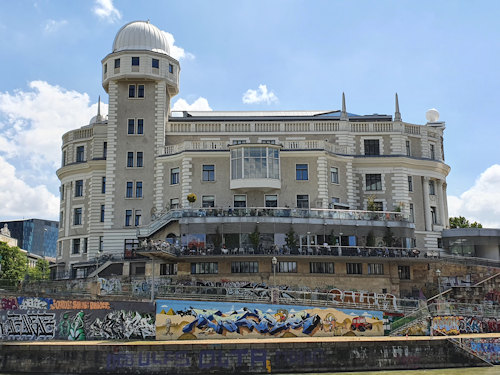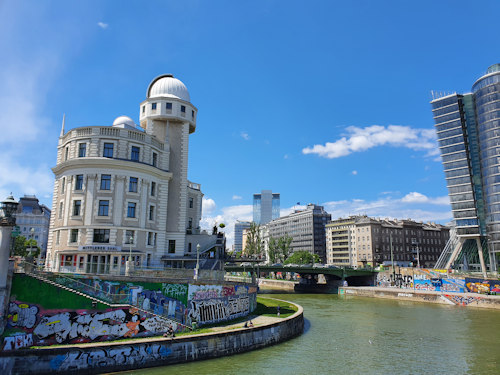
A striking building guards the meeting of waterways where the Donaukanal and River Wien collide. Not a military installation, but an observatory, educational centre, and historical landmark regarded with great affection by locals.
- Built in 1910 to designs by a student of Otto Wagner
- Unique architectural form
- Long history in cultural and scientific education
- See also:
Stars and science

(Main entrance)
Our story begins in the late 19th century with the establishment of a “popular science” organisation modelled on a similar initiative in Germany (the Berlin Urania). The aim was to engage in public education with accessible scientific lectures.
Such upstanding goals demand an appropriate building, which led to the construction in 1909/1910 of a permanent home for the Vienna Urania’s offices and activities.
The official opening, in the presence of Archduke Ferdinand Karl (younger brother of the more famous Franz Ferdinand), took place on June 6th, 1910.
The Urania included an observatory, auditorium and other lecture rooms, cinema facilities, a photographic studio, and similar.
All of which might be considered rather mundane were it not for the cultural impact and architectural timing of the new building; 1910 fell in the era of Vienna Modernism.

(View from the other side of the Donaukanal river channel)
The architect, Max Fabiani (1865-1962), had studied and worked at the feet of the great Otto Wagner, pioneer of modern architecture. His design walked the difficult tightrope of attempting something entirely modern while also keeping to the historical exterior style favoured by the city elders.
Progressive architects of the time, however, might have seen the result as a missed opportunity to build something even more radical.
Fabiani’s handiwork also appears elsewhere in the city, for example at the 1900 house at Kohlmarkt 9 with its remarkable bay windows. Or the plinth and reliefs for the Gutenberg monument on Lugeck square.
Today’s Viennese regard the Urania with notable fondness.
One explanation for this affection is the significance of the position on the city map. The Urania towers over the confluence of the Donaukanal and the River Wien. It also marks the edge of the old town as you drive east in the direction of the airport.

(The Urania sits where the Donaukanal and River Wien come together)
Culturally, the Urania also left an indelible mark on the psyche of the Viennese by introducing them to the wonders of modern science as part of a variety of educational activities (these were pre-Internet and TV days).
For example, the Urania put on the first public performance of film with sound in Austria on June 8th, 1928: a sensation greeted by wild applause. One newspaper wrote the next day (my translation):
The sounds of an overture reached us from the screen. We looked instinctively for the orchestra. But the orchestra is the film.
And a little later added:
It’s impossible to say how the cinema business might be influenced by talking films.

(Also a popular location after the sun goes down)
The building has since seen adaptations, additions and refurbishments, not least because of WWII damage. But it remains largely true to Fabiani’s concept.
And the Urania also retains its original purpose to a large extent.
The location still houses a public observatory, and the Urania Kino serves as one of the host cinemas for Vienna’s most prestigious film festival: the Viennale. The VHS Urania community college offers dozens of (mostly evening) classes.
For those seeking nourishment of a less intellectual and more physical kind, one of today’s occupants is also the KLYO bar and restaurant (with views over the water).
How to get to the Urania
Should you be wandering or cycling along the Donaukanal, you’ll pass the Urania on the southern bank. Other options include:
Subway: a short walk from Schwedenplatz station on the U1 and U4 lines
Tram: the Urania practically has its own stop (Julius-Raab-Platz) served by the 1 and 2 tram lines
Address: Urania Straße 1, 1010 Vienna